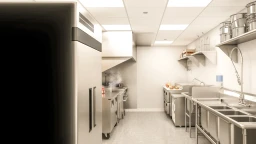6 Licenses and Permits Needed to Open a Restaurant
Table of Contents

Even if you have the perfect location and a fully-equipped kitchen, your food establishment can’t simply throw open your doors and start serving hungry customers. That might have worked in the past, but not today—especially in a time when more than 36 states make it illegal for a child to run a lemonade stand from their front driveway without a food license or health permit.
Put simply, when it comes to licensing and regulation for the restaurant industry, there is a long list of regulatory requirements you must first satisfy before you can flip your front door sign from closed to open for your food establishment.
So, what are the licenses and permits needed to open a restaurant?
- Business License
- EIN
- Certificate of Occupancy (COE)
- Food Service License
- Food Handler Permit
- Liquor License
As a business owner, here’s what you need to know about the restaurant industry.
What are the licenses and permits needed to start a restaurant?
Before we dive in, it’s important to note that every restaurant business may have slightly different requirements to legally operate.
For instance, certain states, cities, or local ordinances could have more stringent safeguards or operational barriers. The type of restaurant business you run, the food you prepare, and the alcohol you serve could necessitate additional actions. Or, if you’re navigating how to start a food delivery service for your restaurant, the requirements will also look different. Chances are, a high-regulatory state like California will have far more dictums than a low-regulatory state, such as Wyoming.
Additionally, keep in mind that some licenses and permits for a new restaurant may take months and cost thousands of dollars to obtain.
To ensure that you, as a restaurant owner, can open up as soon as possible, you must plan early, and be sure to follow the prescribed steps for how to get restaurant permits and licenses. Below are some of the more universal licenses and permits required across the country for a retail food establishment.
Select your legal structure
Practically every business needs to be registered at the local, state, and federal levels for both tax and liability purposes. To do that, you’ll need to select your business structure.
In most cases, a registration fee—typically less than $300—will be required to apply. Also, depending on the business structure you select, you may have to submit different documentation.
The legal structure you choose could have a significant impact on your taxes and potential liability. For a food establishment, the most common legal structures are:
- Sole proprietorship: This is the simplest business structure and the easiest to set up. It involves a single business owner who owns and operates the restaurant. In this case, the restaurant is not a separate business entity; therefore, your business and personal assets and liabilities are one and the same. That means you’re personally responsible for the restaurant’s debts and obligations. Sole proprietors don’t need to register with the state to operate.
- Partnership: This is the simplest business structure for a company with two or more owners. Partnerships operate as a pass-through entity so they aren’t subject to federal income taxes. However, they are still exposed to liability. Partnerships must draft and sign a partnership agreement.
- Limited Liability Company (LLC): This is likely the best option for a restaurant owner, seeing as it differentiates the restaurant’s liabilities from the individual’s. LLCs are required to file an Operating Agreement as well as an Articles of Organization.
Depending on your selected business structure and state of operation, you’ll likely have to register your legal entity name and possibly your Doing Business As (DBA) name as well.
1. Obtain a business license
After you have registered the company at the state level, you’ll need to acquire a business license, which allows you to operate at a local level. In most cases, this license application process is relatively straightforward.
You’ll be required to:
- Register your name
- Designate your legal structure
- Pay a licensing fee (usually between $50-$100)
For most states, you’ll have to renew your license on an annual basis.
2. Apply for an EIN
An employee identification number (EIN) is a unique nine-digit number for your business that functions similarly to a social security number. The IRS assigns the number and uses it for tax purposes.
The vast majority of restaurants will be legally required to apply for an EIN. According to the IRS, if you answer yes to any of the following questions, you’ll need to acquire an EIN:
- Do you have employees?
- Do you operate your business as a corporation or a partnership?
- Do you file any of these tax returns: Employment, Excise, or Alcohol, Tobacco, and Firearms?
- Do you withhold taxes on income, other than wages, paid to a non-resident alien • Do you have employees?
- Do you have a Keogh plan?
Applying for an EIN is FREE and easy. You can do so via mail, fax, telephone, or—the easiest way—online.
3. Get a Certificate of Occupancy (COE)
To run a commercial operation, you’ll also have to designate the property as such. For that, you’ll need a certificate of occupancy. It typically costs around $100. And that’s regardless of whether you rent or own the property.
This essential document provides the government with the following information:
- The classification of the property: This ensures that the building is safely set up for its intended use. For example, you can’t legally operate a restaurant out of your home’s kitchen.
- That the structure is safe and suitable for occupancy: This verifies that the building is up to code, specifically commercial tenant codes, and fit for occupancy.
- The structure adheres to building codes: Restaurants especially, must follow stringent safety guidelines to ensure that conditions are sanitary, food is stored properly, and diners and employees are safe from potential hazards.
How do you get this certificate?
According to The Balance Small Business:
“A certificate of occupancy can be obtained through the local government, usually in the town or county’s building department or department of housing. The request has to be made before any work is actually done. A certificate of occupancy will not be issued, however, until the property has passed all inspection requirements and any fines on the property have been paid.”
4. Food service license
Every restaurant is legally obligated to acquire a food service license.
This food license typically involves an audit of the facilities to ensure that your restaurant abides by food prep, storage, and safety regulations. And even if you’ve recently purchased a fully operational restaurant, you still may have to apply for a new food service license, seeing as some states and cities do not allow food service permits to be transferred from one owner to the next.
You can apply online for a temporary, fixed, or mobile food services license. Costs typically range from $100–$1,000.
5. Food handling permit
Additionally, you may also be required to obtain a food handler license. This demonstrates that your food meets regulations from the health department regarding food storage, sanitation, protection, and food preparation.
In some cases, you may need to also demonstrate that you have applied the 7 principles of Hazard Analysis and Critical Control Points (HACCP), which include:
- Conducting hazard analysis
- Determining critical control points
- Establishing critical limits
- Establishing monitoring procedures
- Establishing corrective actions
- Establishing verification procedures
- Establishing record-keeping and documentation processes
Unlike some other types of permits, this food permit only needs to be renewed once every 3–5 years.
6. Liquor license
Do you intend to sell alcoholic beverages at your restaurant? Despite the added license and paperwork needed, it’s worth it—alcoholic beverages typically account for 20%–25% of a restaurant’s income.
This is often the most expensive and time-consuming restaurant permit to acquire. It often takes months and tens of thousands of dollars. And many cities place a cap on the total number of allowed liquor licenses in the district.
Accordingly, there are several different types of on-license alcohol permits, including:
- Restaurant license: This places a limit on what percentage of income can come from alcohol, typically around 40%.
- Beer and wine license: If you don’t plan on serving hard alcohol or are unable to acquire a liquor license, you’ll need to apply for this permit, which limits you to selling beer and wine only.
- Tavern license: If you plan on operating a business that makes the majority of its revenue off alcohol, you’ll need to acquire this permit.
CloudKitchens – a better way to run a restaurant
Opening up a restaurant is often a complicated, costly, and lengthy process. There are dozens of applications, licenses, and permits you’ll need to successfully obtain in order to even begin selling your food.
But what if there was a better, easier, and cheaper way to open a restaurant?
Join us at CloudKitchens. We’ve reimagined what it looks like to own and operate a restaurant, particularly one focused on delivery. With our ghost kitchens, we make it simple to get a kitchen up and running. It only takes weeks (not months or years) to get started.
By providing you with the kitchen infrastructure you need, we help you avoid all of the logistical and licensing nightmares, saving you time, headache, and money.
Explore ghost kitchen locations across the US:
- Ghost kitchens in San Francisco
- Ghost kitchens in LA
- Ghost kitchens in NYC
- Ghost Kitchens in Toronto
- Ghost Kitchens in Atlanta
- Ghost Kitchens in Dallas
- Ghost Kitchens in Chicago
- Ghost Kitchens in Denver
- Ghost Kitchens in Miami
| DISCLAIMER: This information is provided for general informational purposes only and the content does not constitute an endorsement. CloudKitchens does not warrant the accuracy or completeness of any information, text, images/graphics, links, or other content contained within the blog content. We recommend that you consult with financial, legal, and business professionals for advice specific to your situation. |
Sources:
CNN. Only 14 states allow unpermitted lemonade stands. Country Time wants the others to do the same. https://www.cnn.com/2019/06/19/us/country-time-legalize-lemonade-stands-trnd/index.html
U.S. Small Business Administration. Choose Your Business Name. https://www.sba.gov/business-guide/launch-your-business/choose-your-business-name
IRS. Do You Need an EIN? https://www.irs.gov/businesses/small-businesses-self-employed/do-you-need-an-ein
The Balance Small Business. The Basics of a Certificate of Occupancy. https://www.thebalancesmb.com/what-is-a-certificate-of-occupancy-2125096
FDA. HACCP Principles & Applications. https://www.fda.gov/food/hazard-analysis-critical-control-point-haccp/haccp-principles-application-guidelines
Modern Restaurant Management. Growing Your Restaurant’s Profit Margins. https://modernrestaurantmanagement.com/growing-your-restaurants-profit-margins/
License Locators. Types of Liquor Licenses. https://licenselocators.com/types-of-liquor-licenses/
More insights & stories


